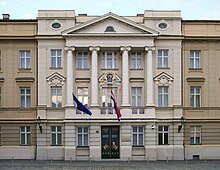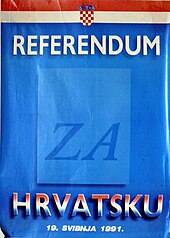1991 Croatian independence referendum
| 1991 Croatian independence referendum | ||
|---|---|---|
| Electorate | 3,652,225 | |
| Turnout | (83.56%) 3,051,881 | |
| Supporting sovereignty and independence of Croatia | ||
| Voting options | Votes | % |
| Yes | 2,845,521 | 93.24 |
| No | 126,630 | 4.15 |
| Supporting Croatia remaining in federal Yugoslavia | ||
| Voting options | Votes | % |
| Yes | 164,267 | 5.38 |
| No | 2,813,085 | 92.18 |
| Source: State Election Committee[1] | ||
 |
|---|
Background

After
In the 1980s, the political situation in Yugoslavia deteriorated, with national tension fanned by the 1986 Serbian
Referendum and declaration of independence

On 25 April 1991, the Croatian Parliament decided to hold an independence referendum on 19 May. The decision was published in the
Croatia subsequently declared independence and dissolved (
Recognition
The Badinter Arbitration Committee was set up by the Council of Ministers of the European Economic Community (EEC) on 27 August 1991 to provide legal advice and criteria for diplomatic recognition to former Yugoslav republics.[27] In late 1991, the Commission stated, among other things, that Yugoslavia was in the process of dissolution, and that the internal boundaries of Yugoslav republics could not be altered unless freely agreed upon.[28] Factors in the preservation of Croatia's pre-war borders, defined by demarcation commissions in 1947,[29] were the Yugoslav federal constitutional amendments of 1971 and 1974, granting that sovereign rights were exercised by the federal units, and that the federation had only the authority specifically transferred to it by the constitution.[4][30]
Germany advocated quick recognition of Croatia, stating that it wanted to stop ongoing violence in Serb-inhabited areas. It was opposed by France, the United Kingdom, and the Netherlands, but the countries agreed to pursue a common approach and avoid unilateral actions. On 10 October, two days after the Croatian Parliament confirmed the declaration of independence, the EEC decided to postpone any decision to recognize Croatia for two months, deciding to recognize Croatian independence in two months if the war had not ended by then. As the deadline expired, Germany presented its decision to recognize Croatia as its policy and duty—a position supported by Italy and Denmark. France and the UK attempted to prevent the recognition by drafting a United Nations resolution requesting no unilateral actions which could worsen the situation, but backed down during the Security Council debate on 14 December, when Germany appeared determined to defy the UN resolution. On 17 December, the EEC formally agreed to grant Croatia diplomatic recognition on 15 January 1992, relying on opinion of the Badinter Arbitration Committee.[31] The Committee ruled that Croatia's independence should not be recognized immediately, because the new Croatian Constitution did not provide protection of minorities required by the EEC. In response, the President Franjo Tuđman gave written assurances to Robert Badinter that the deficit would be remedied.[32] The RSK formally declared its separation from Croatia on 19 December, but its statehood and independence were not recognized internationally.[33] On 26 December, Yugoslav authorities announced plans for a smaller state, which could include the territory captured from Croatia,[34] but the plan was rejected by the UN General Assembly.[35]
Croatia was first recognized as an independent state on 26 June 1991 by
Aftermath
Although it is not a public holiday, 15 January is marked as the day Croatia won international recognition by Croatian media and politicians.
See also
References
- ^ a b "Izviješće o provedenom referendumu" [Report on performed referendum] (PDF) (in Croatian). State Election Committee. 22 May 1991. Archived from the original (PDF) on 27 February 2012. Retrieved 27 December 2011.
- ISSN 0353-295X. Retrieved 14 October 2011.
- ^ Vlado Vurušić (6 August 2009). "Heroina Hrvatskog proljeća" [Heroine of the Croatian Spring]. Jutarnji list (in Croatian). Archived from the original on 6 August 2012. Retrieved 14 October 2011.
- ^ . Retrieved 18 October 2011.
- ^ Frucht 2005, p. 433.
- ^ "Leaders of a Republic in Yugoslavia Resign". The New York Times. Reuters. 12 January 1989. Archived from the original on 6 November 2012. Retrieved 7 February 2010.
- ISSN 1847-2397. Retrieved 11 December 2010.
- ^ Branka Magas (13 December 1999). "Obituary: Franjo Tudjman". The Independent. Archived from the original on 10 November 2012. Retrieved 17 October 2011.
- ^ "Armed Serbs Guard Highways in Croatia During Referendum". The New York Times. 20 August 1990. Retrieved 11 December 2010.
- ISBN 978-3-8329-5609-7. Retrieved 27 December 2011.
- ^ Chuck Sudetic (2 October 1990). "Croatia's Serbs Declare Their Autonomy". The New York Times. Archived from the original on 12 November 2012. Retrieved 11 December 2010.
- ISBN 978-1-85743-058-5. Retrieved 16 December 2010.
- ^ Narodne Novine(in Croatian). 2 May 1991. Retrieved 27 December 2011.
- ^ "Croatia Calls for EC-Style Yugoslavia". Los Angeles Times. 16 July 1991. Retrieved 20 December 2010.
- ^ Sudetic, Chuck (20 May 1991). "Croatia Votes for Sovereignty and Confederation". The New York Times. Retrieved 12 December 2010.
- Hrčak.
- ^ a b Chuck Sudetic (26 June 1991). "2 Yugoslav States Vote Independence To Press Demands". The New York Times. Archived from the original on 10 November 2012. Retrieved 12 December 2010.
- Narodne Novine(in Croatian). 25 June 1991. Retrieved 12 December 2010.
- ^ Riding, Alan (26 June 1991). "Europeans Warn on Yugoslav Split". The New York Times. Retrieved 12 December 2010.
- ^ Sudetic, Chuck (29 June 1991). "Conflict in Yugoslavia; 2 Yugoslav States Agree to Suspend Secession Process". The New York Times. Retrieved 12 December 2010.
- ^ Sudetic, Chuck (6 October 1991). "Shells Still Fall on Croatian Towns Despite Truce". The New York Times. Retrieved 16 December 2010.
- ^ "Yugoslav Planes Attack Croatian Presidential Palace". The New York Times. 8 October 1991. Retrieved 13 December 2010.
- ^ Williams, Carol J. (8 October 1991). "Croatia Leader's Palace Attacked". Los Angeles Times. Retrieved 23 January 2011.
- Sabor. 7 October 2008. Retrieved 28 December 2011.
- ^ Dražen Boroš (8 October 2011). "Dvadeset godina slobodne Hrvatske" [Twenty years of free Croatia] (in Croatian). Glas Slavonije. Retrieved 29 December 2011.
- Narodne Novine(in Croatian). 15 November 2019. Retrieved 20 May 2021.
- ISSN 0032-3241. Retrieved 18 June 2012.
- doi:10.1093/oxfordjournals.ejil.a035802. Archived from the original(PDF) on 29 May 2011.
- ISSN 0570-9008. Retrieved 20 June 2012.
- ISSN 1847-0459. Retrieved 10 December 2010.
- ISBN 978-90-411-1439-6. Retrieved 27 December 2011.
- ^ Roland Rich (1993). "Recognition of States: The Collapse of Yugoslavia and the Soviet Union" (PDF). European Journal of International Law. 4 (1): 48–49. Archived from the original (PDF) on 21 April 2012. Retrieved 30 November 2011.
- ISBN 978-90-411-1890-5. Retrieved 28 December 2011.
- ^ "Serb-Led Presidency Drafts Plan For New and Smaller Yugoslavia". The New York Times. 27 December 1991. Retrieved 28 December 2011.
- ^ "A/RES/49/43 The situation in the occupied territories of Croatia" (PDF). United Nations. 9 February 1995. Archived from the original (PDF) on 19 May 2015. Retrieved 28 December 2011.
- Ministry of Foreign Affairs and European Integration (Croatia). Archived from the originalon 13 August 2010. Retrieved 18 December 2011.
- ^ Stephen Kinzer (24 December 1991). "Slovenia and Croatia Get Bonn's Nod". The New York Times. Archived from the original on 20 June 2012. Retrieved 29 July 2012.
- ^ Paul L. Montgomery (23 May 1992). "3 Ex-Yugoslav Republics Are Accepted into U.N." The New York Times. Archived from the original on 11 November 2012. Retrieved 29 July 2012.
- ^ "Obilježena obljetnica priznanja" [Recognition Anniversary Marked] (in Croatian). Croatian Radiotelevision. 15 January 2011. Archived from the original on 5 September 2012. Retrieved 29 December 2011.
- ^ "Commemorative 25 Kuna Coins in Circulation". Croatian National Bank. 19 May 2010. Archived from the original on 16 December 2011. Retrieved 29 December 2011.
- ^ Sudetic, Chuck (18 November 1991). "Croats Concede Danube Town's Loss". The New York Times. Retrieved 15 December 2010.
- ^ Binder, David (9 November 1991). "Old City Totters in Yugoslav Siege". The New York Times. Retrieved 16 December 2010.
- ^ Sudetic, Chuck (3 January 1992). "Yugoslav Factions Agree to U.N. Plan to Halt Civil War". The New York Times. Retrieved 16 December 2010.
- ^ Dean E. Murphy (8 August 1995). "Croats Declare Victory, End Blitz". Los Angeles Times. Archived from the original on 12 October 2012. Retrieved 18 December 2010.
- ^ Chris Hedges (16 January 1998). "An Ethnic Morass Is Returned to Croatia". The New York Times. Archived from the original on 18 May 2013. Retrieved 18 December 2010.
Sources
- Frucht, Richard C. (2005). Eastern Europe: An Introduction to the People, Lands, and Culture. Vol. 1. ISBN 1-57607-800-0.
